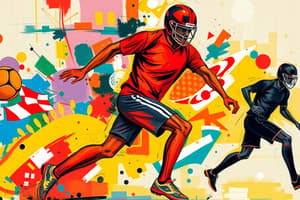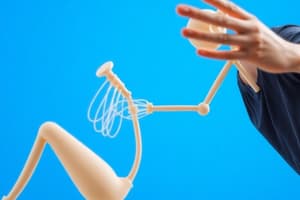Podcast
Questions and Answers
What is motor learning?
What is motor learning?
Motor learning refers to the relatively permanent gains in motor skill capability associated with practice or experience. It involves a multifaceted set of internal processes that effect relatively permanent change in human performance through practice, excluding changes due to maturation, temporary state, or instinct.
What is motor control?
What is motor control?
Motor control is the study of postures and movements and the mechanisms that underlie them. It examines how an individual executes designated motor skills through the neuromuscular control process in response to external environmental demands.
What is motor development?
What is motor development?
Motor development refers to the continuous, age-related process of change in movement, considering the interacting factors within the individual, environment, and task that drive these changes.
What is motor behavior?
What is motor behavior?
What is motor performance?
What is motor performance?
All human actions or movements are the result of a neuromuscular integrated brain and body controlled process.
All human actions or movements are the result of a neuromuscular integrated brain and body controlled process.
According to Figure 1.1, what are the three stages of information processing when responding to an attack?
According to Figure 1.1, what are the three stages of information processing when responding to an attack?
List the five characteristics of motor learning shown in Figure 1.2.
List the five characteristics of motor learning shown in Figure 1.2.
Motor learning is an external process that can be directly observed.
Motor learning is an external process that can be directly observed.
Once a motor skill is learned, it is forgotten very easily.
Once a motor skill is learned, it is forgotten very easily.
According to Table 1.1, what are the three components of motor control areas?
According to Table 1.1, what are the three components of motor control areas?
According to Table 1.2, what three major components contribute to motor performance?
According to Table 1.2, what three major components contribute to motor performance?
Why is understanding motor learning important for physical education teachers?
Why is understanding motor learning important for physical education teachers?
How can knowledge of motor learning benefit physical therapists?
How can knowledge of motor learning benefit physical therapists?
What is kinematic movement?
What is kinematic movement?
What is the difference between scientific knowledge and empirical knowledge in motor learning?
What is the difference between scientific knowledge and empirical knowledge in motor learning?
Flashcards
Motor Learning
Motor Learning
Gains in motor skill capability associated with practice/experience.
Motor Behavior
Motor Behavior
Executed human performances and postures resulting from an integrated internal process leading to relatively permanent change.
Motor Control
Motor Control
Study of posture, movement, and their underlying mechanisms.
Motor Development
Motor Development
Signup and view all the flashcards
Motor Performance
Motor Performance
Signup and view all the flashcards
Motor Control: Responding
Motor Control: Responding
Signup and view all the flashcards
Motor Control: Decision-making
Motor Control: Decision-making
Signup and view all the flashcards
Motor Control: Reflex
Motor Control: Reflex
Signup and view all the flashcards
Kinematic movement
Kinematic movement
Signup and view all the flashcards
Empirical Knowledge
Empirical Knowledge
Signup and view all the flashcards
Motor Learning = Internal
Motor Learning = Internal
Signup and view all the flashcards
Motor Learning = Processes
Motor Learning = Processes
Signup and view all the flashcards
Motor Learning = Habits
Motor Learning = Habits
Signup and view all the flashcards
Motor Learning = Permanent
Motor Learning = Permanent
Signup and view all the flashcards
Motor Learning = Negative
Motor Learning = Negative
Signup and view all the flashcards
Study Notes
Basic Concepts of Applied Motor Learning and Performance
- Motor learning is defining its relationship to related disciplines. These disciplines are motor control, motor development, motor behaviors, and motor performance.
- Understanding motor learning principles can be applied to professions like physical education, exercise and sports science, sports coaching, physical therapy, the military, police and special forces, ballet and other dance forms, and recreational activities
- New technology/training methods enhance the motor learning process.
- Research methods are important for motor learning performance.
Introduction
- Gabby Douglas, Michael Jordan, and Bruce Lee all demonstrate incredible movements.
- Most human movements are learned skills, requiring coordination of 656 skeletal muscles.
- Movements result from a neuromuscular process controlled by the brain and body.
- Billions of nerve cells coordinate movements.
- Mastering fundamental motor skills to become elite requires overcoming tremendous challenges.
- Slight deviations in movements can lead to failure or injury in sports like football and martial arts.
- Proper training is essential for coordinated movements.
Motor Learning
- Kicking a ball, throwing a rock, or shooting a basketball are easy motor tasks, but children cannot perform them properly without learning.
- Motor learning is essential for many human movements, especially in movement-related professions.
- It refers to relatively permanent gains in motor skill capability associated with practice/experience.
- Motor learning is vital for physical education, kinesiology, exercise and sports science, coaching education, physical therapy, and the military.
- It's a multifaceted set of internal processes for permanent change in human performance through practice.
- Changes in motor skills should not be attributed to maturation, temporary state, or instinct.
- The main objective of motor learning is to make permanent changes in the neurological functions in the brain.
- People learn many motor skills for various purposes, with some skills being complex and others easily learned.
- Sports scientists seek effective training approaches for learners to master skills efficiently in minimal time.
Characteristics of Motor Learning
- Motor learning is an internal process not observable externally.
- The amount learned is unknown from an outsider's perspective.
- Muscular movements reflect brain activities, providing indirect assessment of learning progress.
- Motor learning is a set of processes for reaching specific learning objectives.
- Different types of learning yield different results.
- Sports scientists seek the best motor learning processes for specific skills based on individual differences.
- The goal is to form designated motor behavior habits through proper training.
- Once learned, a motor skill becomes relatively permanent and not easily forgotten (e.g., riding a bike).
- Motor learning is not value-free and can negatively form a bad habit hard to change once formed.
Motor Behavior & Control
- Several academic disciplines are related to motor learning: motor behavior, motor control, motor development, and motor performance.
- Kinesiology departments often offer these courses separately at the graduate level, but many schools only offer motor learning and motor development at the undergraduate level.
- Motor behavior can be considered the study of executed human performances and postures which leads to a relatively permanent change in performance.
- Motor control is the study of postures, movements, and their underlying mechanisms.
- It involves how an individual executes motor skills through neuromuscular control processes in response to external environmental demands.
- Race car drivers quickly process information to find open spaces for success.
- Motor control deals with information processing, attention, interferences, and movement mechanisms.
- Table 1.1 shows the three components of motor control areas of human movements.
Components of Motor Control
- Neuromuscular mechanism of responding to external stimuli
- Neuromuscular mechanism of decision-making in advance for taking actions
- Unconscious control mechanism for controlling reflex movements
- Understanding the human brain's control mechanisms helps design motor learning processes according to neuromuscular control systems.
- Neuromuscular control mechanisms for high jumping and boxing differ significantly.
- High jumping can be planned, while boxing relies on immediate external stimuli.
- High jumpers need advanced planning and consistent movement control, while boxers need speed, timing, and accuracy.
- Examination of extero- and proprio-sensory information, decision-making speed, and action programming are important for boxing goals.
- The human brain controls coordinated movements in response to varied external environmental demands.
Motor Development & Performance
- Motor development is a continuous, age-related process of change in movement.
- Interacting factors like individual, environment, and task drive these changes.
- It studies the growth and developmental process of human movements.
- It examines how the learning process affects the developmental process.
- Understanding normal growth and development helps teachers and practitioners effectively teach motor skills to various populations.
- Motor performance is an end result of executing a motor skill observable externally.
- Coaches can assess a tennis player's game and practice performance.
- Instructors can observe and assess motor skills like forehand/backhand strokes or serving.
Factors Contributing to Motor Performance
- Learner's characteristics (age, gender, experience, cognitive ability, genetic traits, psychological characteristics, etc.)
- Instructor's competence (sports science background, athletic experience, knowledge of sport, administration and communication skill, human relation skills, etc.)
- Learning environment and conditions (undistractive learning environment, facility/equipment, sports field/settings, organization of training)
- Instructors can observe student performance to understand how much they have learned, as learning takes place internally.
- Students can explain motor skill structures or distinguish correct/incorrect demonstrations to test understanding.
Applications of Motor Learning
- Motor learning has broad implications in fields ranging from elementary school to the Olympic level.
- It also applies to recreational sports to the military, non-competitive to combat institutions, and individual to team sports.
- Teaching emphasis varies based on the purpose of motor learning, required motor skills, and learners' needs.
- Elementary schoolers learn basic motor skills like kicking, throwing, jumping, running, catching, or climbing.
- These skills transfer to sports-related movements.
- The Olympic level focuses on achieving peak performance in competition.
- In physical education (elementary to college), students learn motor skills for fitness, fun, and a healthy lifestyle.
- Motor skill learning is a key objective in school programs.
- Limited class time requires teachers to teach proper motor skills for exercise and sports.
- Harter's perceived competence motivation theory suggests being good at something enhances motivation.
- Mastering motor skills makes students more likely to keep playing sports as lifelong leisure activities.
- Effective motor skills teaching in schools impacts future lifestyles and exercise habits.
- School physical education teachers should understand motor learning principles.
Professionals Improving Motor Skills
- Exercise and sports science professionals use motor learning to design effective training programs.
- Major responsibilities include engaging athletes in strength and conditioning.
- Understanding motor learning allows proper training program design for athletes.
- Understanding motor skills helps fitness professionals design training programs for enjoyment and personal goals.
- Certain sports pose injury vulnerabilities. Knowledge of motor skills helps sports scientists advise athletes on injury prevention.
- Exercise programs correlate directly with chosen sports skill training.
- Knowledge of motor learning principles is advantageous for teaching/consultation activities for exercise science specialists.
- Coaches enhance athletes' technical skills for performance determined by these skills, physical ability, and psychological well-being.
- Technical abilities play a crucial role in competitions.
- Coaches should teach proper technical skills and develop creative new training methods for extra competition advantages.
Motor Learning
- Superior technical routines can become outdated quickly. Human performance limits on motor skills are constantly being surpassed.
- Gymnastic routines once perceived impossible are now being executed.
- Repeated breaking of 100-meter race records demonstrates progress.
- Efforts of sports scientists and coaches have advanced technical training to make once impossible skills attainable.
- This is attributed to advancing knowledge about motor learning and human movement potentials.
- Motor skill learning in coaching is a key factor for peak competition performance.
- Physical therapists help patients recover from injuries through rehabilitation, assessing their ability to perform movements/motor skills.
- By identifying capabilities, the most effective treatment methods are determined.
- Sports injuries are sometimes unavoidable. A speedy recovery is crucial for athletes to regain condition, maintain routines, self-confidence, and achieve peak performance.
- Therefore, knowledge of motor learning enables evaluation of injury degree, creating rehabilitation strategies, and assessing recovery.
- This knowledge base allows for accurate recommendations on resuming technical training post-injury.
- Understanding motor skills helps physical therapists develop treatment strategies for patients' recovery and future injury prevention.
Military Applications
- Motor learning principles are used widely in military settings because there is combat with bare hands or various weapons under severe conditions.
- In battle, slight delays in action can be life-threatening.
- Efficient, forceful, and timely soldier reactions and swift fighting abilities are significant in winning battles and saving lives.
- Military, special forces, ground soldiers, and police officers need various motor skills for their responsibilities.
- With motor learning principles, trainers can develop appropriate training regimes for job requirements.
- Ballet and other dance forms involve artistic, beautiful, and swift movements that take years to perfect. Dancing instructors should learn human anatomy and motor learning in order to understand relationships between a dancer's anatomical capability and performance.
Kinematic Movement
- Refers to a technique, body posture, movement pattern, process of movement, or structure of movement which can only be evaluated by subjective approaches.
- By using scientific principles, dancers can speed up learning, especially for difficult and challenging movements that need perfect coordination among different dancers, split-second timing of the jumps and turns, and excellent body kinematics of the movements.
- Since dancing movements are considered process-oriented motor skills, dancers can't see own movements during practice of performance. Thus they must rely on instruction.
- Without external feedback, learning of motor skills can't occur. If instructor can't grasp the key structures of certain motor skill, learning progress will be significantly compromised.
- Dancing instructors should understand more clearly the critical components of dancing routines and properly teach the skill transitions accordingly.
- In fact, dance is a great exercise for youngsters and adults. Dancing for pleasure, competition, and exercise.
Conclusion
- Besides professional athletes, many amateur athletes regularly engage in different recreational sports or other physical activities in their spare time.
- Many would like to learn motor skills to enhance enjoyment or for self-improvement and competition.
- Many of these serve as coaches teaching skill to children training.
- Thousands of sport clubs or sport organizations exist that provide opportunities for people of all ages to participate in sport.
- Therefore motor learning knowledge would be very beneficial.
Understanding Basic Scientific Methods
- Practitioners regularly face challenges and solve practical problems through scientific or trial and error approaches.
- Any gained based on experience must be validated through scientific methods and then the knowledge gained can become theory.
- If this knowledge is not validated through scientific methods, it is called empirical knowledge.
- The advantages of the empirical approach for gaining knowledge are that it is convenient, flexible, and case oriented.
- The disadvantages are that the results may be biased, invalid, or unreliable.
Studying That Suits You
Use AI to generate personalized quizzes and flashcards to suit your learning preferences.




